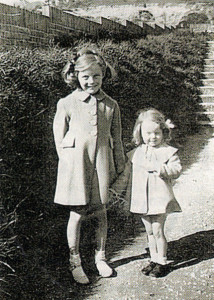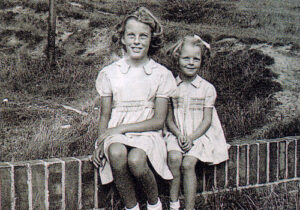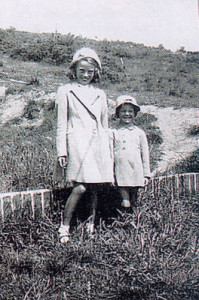
When we were children our mother made all the clothes for my sister and me while my grandmother knitted garments for the whole family. For most of our childhood, we accepted our ‘designer outfits’ as normal, only occasionally proudly displaying hidden pockets or fastenings to impress friends.
My mother loved sewing but had never been taught professionally. She’d learned basic needlework from her mother but could never follow a bought pattern with ease. All her designs were formed in her head and cut out from basic shapes which were modified to each style.
‘Siren suits’, complete with hoods, were the favourite clothes for playing outdoors on cold winter days when I was very young. I remember three – one red, one blue and one camel-coloured.
As I was something of a ‘tomboy’ dresses and skirts tended to get ripped while climbing trees and playing cowboys and indians with my cousins and the local boys. My mother resolved her despair by making dungarees and what must have been the first ‘hot pants’, for me to wear during the summer, which were ideal for tree- climbing, but which did subject me to being teased and called a boy.
Just after the war she made me a smart outfit for my solo poetry reading at the school speech day. As I proudly told my teacher, the blue skirt was made from an old one of my mother’s, the little red jack-
et had been a coat of my sister’s and the white blouse made from much-treasured parachute nylon which my father had acquired.
One of her favourite occupations, however, was ‘smocking’. Both my sister and I had smocked dresses -matching materials but different styles, as my sister was 5 and a 1/4 years older than myself. I still have the smocked panel of one dress she made – the dress itself, alas, was re-used to make a blouse when I had outgrown it!
I did learn the technique for smocking, and still remember helping mother mark the spaced dots on the material through the holes of the pattern. Regrettably, smocking later went out of fashion.

Looking at old photographs, I’m still amazed by the ingenuity and versatility with which she managed during the war, often using outgrown clothes to create much-admired wardrobes, which we took so much for granted. (She also made matching knickers for all my dresses!)
Nor did her talents stop with making our clothes. All my dolls had very fetching outfits and the frilled sheets, pillow cases and quilted cover of my doll’s pram were the envy of my friends. When my sister and I had outgrown our coats of deep rose pink made when I was five, Tommy, my favourite black china-headed doll, was given for Christmas a complete new outfit
of short trousers with crossover buttoned straps, a double-breasted jacket with reveres, and a jaunty peaked cap with a button at the centre of the crown all in deep rose pink! He looked the cat’s whiskers!
When my daughter was very small I made a few dresses for her, but as the range of children’s clothes widened it became easier to buy, although I still knitted her jumpers and jackets.
I never had the natural skills of my mother for creating clothes, nor the incentive of necessity to develop them.,
Ann Savage









